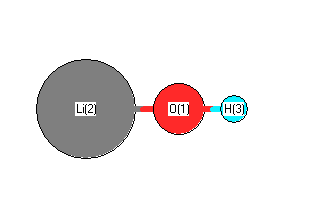Vibrational Frequencies calculated at B2PLYP=FULL/aug-cc-pVTZ
| Mode Number |
Symmetry |
Frequency
(cm-1) |
Scaled Frequency
(cm-1) |
IR Intensities
(km mol-1) |
Raman Act
(Å4/u) |
Dep P |
Dep U |
|---|
| 1 |
Σ |
3998 |
3835 |
37.20 |
|
|
|
| 2 |
Σ |
947 |
909 |
173.77 |
|
|
|
| 3 |
Π |
360 |
345 |
125.06 |
|
|
|
| 3 |
Π |
360 |
345 |
125.06 |
|
|
|
Unscaled Zero Point Vibrational Energy (zpe) 2832.0 cm
-1
Scaled (by 0.9594) Zero Point Vibrational Energy (zpe) 2717.0 cm
-1
See section
III.C.1 List or set vibrational scaling factors
to change the scale factors used here.
See section
III.C.2
Calculate a vibrational scaling factor for a given set of molecules
to determine the least squares best scaling factor.
